Related Research Articles
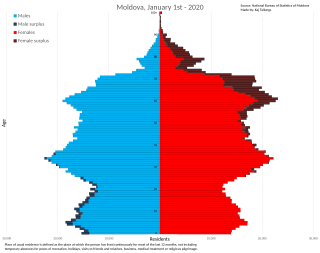
Demographic features of the population of Republic of Moldova include distribution, ethnicity, languages, religious affiliation and other statistical data.
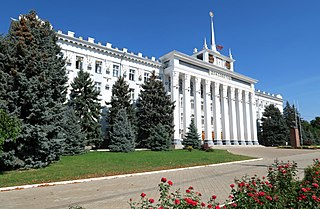
Tiraspol is the capital and largest city of Transnistria, a breakaway state of Moldova, where it is the third-largest city. The city is located on the eastern bank of the Dniester River. Tiraspol is a regional hub of culture, economy, tourism, and light industry, such as furniture and electrical goods production.

Transnistria, or Pridnestrovie, officially known as the Pridnestrovian Moldavian Republic (PMR), is a breakaway state internationally recognized as part of Moldova. Transnistria controls most of the narrow strip of land between the Dniester river and the Moldova–Ukraine border, as well as some land on the other side of the river's bank. Its capital and largest city is Tiraspol. Transnistria is officially designated by the Republic of Moldova as the Administrative-Territorial Units of the Left Bank of the Dniester or as Stînga Nistrului.

Bender or Bendery, also known as Tighina, is a city within the internationally recognized borders of Moldova under de facto control of the unrecognized Pridnestrovian Moldavian Republic (Transnistria) (PMR) since 1992. It is located on the western bank of the river Dniester in the Romanian historical region of Bessarabia.

The politics of Transnistria, a de facto independent state situated de jure within the Republic of Moldova in Eastern Europe, take place in a framework of a semi-presidential republic, whereby the President of Transnistria is head of state and the Prime Minister of Transnistria is head of government. Executive power is exercised by the government. Legislative power is vested in both the government and parliament. Formally, Transnistria has a multi-party system and a unicameral parliament, called the Supreme Council. The president is elected by popular vote. The latest parliamentary elections were held in November 2020.

The Transnistrian War was an armed conflict that broke out on 2 November 1990 in Dubăsari between pro-Transnistria forces, including the Transnistrian Republican Guard, militia and neo-Cossack units, which were supported by elements of the Russian 14th Army, and pro-Moldovan forces, including Moldovan troops and police.
The 2004 Moldovan census was carried out between October 5 and October 12, 2004. The breakaway Transnistria failed to come into an agreement with the central government in Chişinău, and carried out its own census between November 11 and November 18, 2004. The results of the census in Transnistria were put into question.

The Transnistria conflict is an ongoing frozen conflict between Moldova and the unrecognized state of Transnistria. Its most active phase was the Transnistria War. There have been several attempts to resolve the conflict, although none have been successful. The conflict may be considered as having started on 2 September 1990, when Transnistria made a formal sovereignty declaration from Moldova.

This is the history of Transnistria, officially the Pridnestrovian Moldavian Republic (PMR), an unrecognised breakaway state that is internationally recognised as part of Moldova. Transnistria controls most of the narrow strip of land between the Dniester river and the Moldovan–Ukrainian border, as well as some land on the other side of the river's bank.

Chițcani is a commune in Căușeni District, Moldova. It consists of the village Chițcani and two small villages (hamlets), Merenești and Zahorna. Chițcani is situated to the south-east of the city of Tighina (Bender). The locality, although situated on the right (western) bank of the river Dniester, is under the control of the breakaway Transnistrian authorities. On the opposite side of the river lies the city of Tiraspol.
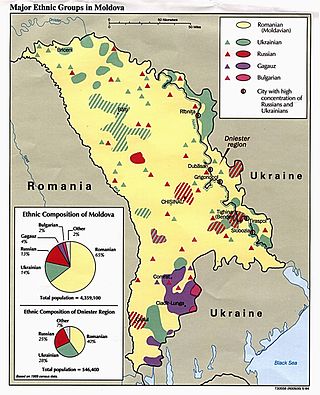
The Romanian-language schools in Transnistria are subject to limitations by the government of Transnistria, an unrecognized breakaway region of Moldova since 1992.
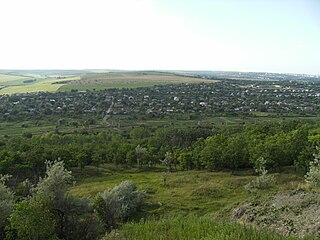
Gîsca is a village near in Căușeni District, Moldova, composed of a single village with the same name, population 4,841 at the 2004 Census. The locality, although situated on the right (western) bank of the river Dniester, immediately to the south-west of the city of Tighina (Bender), in the Bessarabian, not Transnistrian part of Moldova, is under the control of the breakaway Transnistrian authorities.

The state of affairs with human rights in Transnistria has been criticized by several governments and international organizations. The Republic of Moldova, and other states and non-governmental organizations (NGOs) claim that the government of Transnistria is authoritarian and has a record of arbitrary arrest and torture.

The 1989 Transnistrian census was organized by the authorities of the MSSR in the final days of its existence as a Soviet republic. It took place as part of the Soviet Census of 1989.
Varnița is a village in the Anenii Noi District, Moldova, located near Bender (Tighina). It is also considered a suburb of Bender. After the 1992 War of Transnistria, Varnița remained controlled by the government of the Republic of Moldova, while the city of Bender is controlled by the authorities of Transnistria.
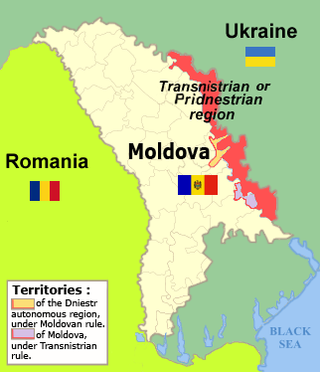
A demographic history of Transnistria shows that Transnistria has been home to numerous ethnic groups, in varying proportions, over time.

This timeline of events is a chronological list of incidents and other notable occurrences related to the War of Transnistria, including events leading up to the war.
The 2014 Moldovan census was held between 12 and 25 May 2014. It was organized by National Bureau of Statistics of the Republic of Moldova.

The government of Transnistria, a breakaway state internationally recognized as part of Moldova, has requested annexation by Russia numerous times. Transnistria is a territory that separated itself from Moldova due to fear of a possible unification of the latter with Romania. This sparked the Transnistria War, in which Russian-backed Transnistria managed to stay separate from Moldova. Despite this, today Transnistria is legally and internationally considered part of Moldova.
The 2015 Transnistrian census was organized in the unrecognized state of Transnistria in 2015. It was held after Moldova, internationally recognized as the owner of the state's territory, made a census in 2014.
References
- ↑ (in Russian) Official census results reported by Transnistrian authorities Archived 2012-11-05 at the Wayback Machine
- ↑ "TRANSNISTRIAN PARLIAMENT ADJOURNS POPULATION CENSUS FOR ONE MORE YEAR", February 5, 2015 (retrieved April 3, 2017)